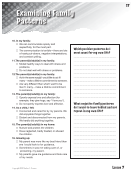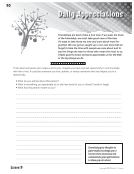Copyright 2025 Marline E. Pearson
LESSON 6 • 107
❖ (PP) Conclude with these key points: The video clip, Tea and Consent,
did a great job of showing what consent is and is not. It underscores an
important point—don’t go on assumptions when it comes to sex.
• Whether it’s not hearing or not saying a direct “no” and the other
person assuming it’s “yes”. Silence is never consent.
• Or, assuming because they had sex before, a person wants to again. Or
a person feeling they must engage again.
• Or, because the process of getting physical has started, one assumes it has to continue. Just because
one says yes to one activity (e.g., kissing, touching, grinding, etc.) does not imply consent to another.
The action must be stopped instantly when consent is withdrawn, as in “No. I don’t want this.”
• Or, assuming boys always want sex. Consent should be a two-way street. Boys, too, must voluntarily
agree to physical intimacy. And erections do not equal consent and should not be subject to
manipulation or pressure from girls or other guys.
• And, when someone or both are under the influence of alcohol or other drugs, consent is not possible,
and in many states, it could be charged as sexual assault.
• Consent also applies to digital images. If a person receives a sexually explicit photo/video, they cannot
forward it or post it without permission. And, if the person is under 18, possession or distribution
(even if consensual) may be in violation of child sexual abuse material laws and prosecuted.
❖ (PP) Consent needs the full use of your pre-frontal cortex or what we might
call your higher-smart brain. This part of your brain allows reason, logic,
judgment, and decision-making. Once sexually aroused or under the influence
of alcohol or other drugs, it’s hard to tap the full power of your higher brain.
• The safest way to be sure things are consensual is to talk before
engaging in physical intimacy and in a sober state.
• Sex should involve mutuality. That means mutual power (equality), mutual desire, and mutual pleasure.
• It takes time to get to know someone and build trust to have the kinds of honest conversations to know
if you’re on the same page about what you’re doing.
• In a healthy relationship, both partners feel comfortable with the level of physical activity, whether
that means holding hands, kissing, or touching, on to greater physical involvement.
• You are in charge of how far you want to take it with someone.
Consent and Your Brain
LESSON 6 • 107
❖ (PP) Conclude with these key points: The video clip, Tea and Consent,
did a great job of showing what consent is and is not. It underscores an
important point—don’t go on assumptions when it comes to sex.
• Whether it’s not hearing or not saying a direct “no” and the other
person assuming it’s “yes”. Silence is never consent.
• Or, assuming because they had sex before, a person wants to again. Or
a person feeling they must engage again.
• Or, because the process of getting physical has started, one assumes it has to continue. Just because
one says yes to one activity (e.g., kissing, touching, grinding, etc.) does not imply consent to another.
The action must be stopped instantly when consent is withdrawn, as in “No. I don’t want this.”
• Or, assuming boys always want sex. Consent should be a two-way street. Boys, too, must voluntarily
agree to physical intimacy. And erections do not equal consent and should not be subject to
manipulation or pressure from girls or other guys.
• And, when someone or both are under the influence of alcohol or other drugs, consent is not possible,
and in many states, it could be charged as sexual assault.
• Consent also applies to digital images. If a person receives a sexually explicit photo/video, they cannot
forward it or post it without permission. And, if the person is under 18, possession or distribution
(even if consensual) may be in violation of child sexual abuse material laws and prosecuted.
❖ (PP) Consent needs the full use of your pre-frontal cortex or what we might
call your higher-smart brain. This part of your brain allows reason, logic,
judgment, and decision-making. Once sexually aroused or under the influence
of alcohol or other drugs, it’s hard to tap the full power of your higher brain.
• The safest way to be sure things are consensual is to talk before
engaging in physical intimacy and in a sober state.
• Sex should involve mutuality. That means mutual power (equality), mutual desire, and mutual pleasure.
• It takes time to get to know someone and build trust to have the kinds of honest conversations to know
if you’re on the same page about what you’re doing.
• In a healthy relationship, both partners feel comfortable with the level of physical activity, whether
that means holding hands, kissing, or touching, on to greater physical involvement.
• You are in charge of how far you want to take it with someone.
Consent and Your Brain







































































































































































































































































































































































































































































